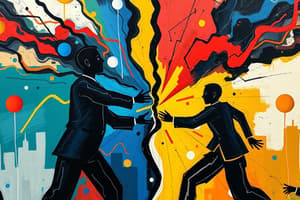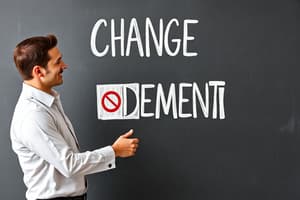Podcast
Questions and Answers
Which of the following scenarios best exemplifies the application of Lewin's Three-Step Model in change management?
Which of the following scenarios best exemplifies the application of Lewin's Three-Step Model in change management?
- A company introduces a new performance appraisal system but fails to provide feedback or address employee concerns, resulting in minimal impact.
- A company first communicates the need for a new customer relationship management (CRM) system (Unfreeze), then trains employees on how to use it (Change), and finally integrates the new system into daily operations and establishes ongoing support (Refreeze). (correct)
- A company implements a new software system without informing employees beforehand, leading to widespread confusion and resistance.
- A company attempts to change its organizational structure overnight without any preparation, resulting in chaos and decreased productivity.
In the context of organizational conflict, which approach is most likely to foster a collaborative environment and lead to innovative solutions?
In the context of organizational conflict, which approach is most likely to foster a collaborative environment and lead to innovative solutions?
- Prioritizing individual interests and asserting dominance to ensure one's own perspective prevails.
- Avoiding conflict altogether to maintain a harmonious workplace, even if underlying issues remain unresolved.
- Actively seeking to understand different viewpoints, encouraging open dialogue, and working together to find mutually beneficial solutions. (correct)
- Compromising by splitting the difference, where each party concedes some points but no one achieves their ideal outcome.
A project manager consistently relies on gut feelings and intuition when making critical decisions, often disregarding data and analysis. Which of the following concepts best describes this approach?
A project manager consistently relies on gut feelings and intuition when making critical decisions, often disregarding data and analysis. Which of the following concepts best describes this approach?
- Intuitive decision-making. (correct)
- Rational decision-making.
- Cost-benefit analysis.
- Bounded rationality.
An organization is undergoing a major restructuring. Which of the following actions would be most effective in minimizing resistance to change among employees?
An organization is undergoing a major restructuring. Which of the following actions would be most effective in minimizing resistance to change among employees?
Which of the following statements best describes the role of organizational culture in fostering innovation?
Which of the following statements best describes the role of organizational culture in fostering innovation?
What is the primary goal of conflict management within an organization?
What is the primary goal of conflict management within an organization?
When facing a complex decision with numerous stakeholders and conflicting priorities, which decision-making technique would be most effective in gathering diverse perspectives and building consensus?
When facing a complex decision with numerous stakeholders and conflicting priorities, which decision-making technique would be most effective in gathering diverse perspectives and building consensus?
An organization is consistently underperforming due to inefficient processes and lack of coordination between departments. Which of the following organizational design principles should be prioritized to address these issues?
An organization is consistently underperforming due to inefficient processes and lack of coordination between departments. Which of the following organizational design principles should be prioritized to address these issues?
During a period of significant organizational change, what is the most important role of leadership?
During a period of significant organizational change, what is the most important role of leadership?
Which of the following examples demonstrates the use of 'framing bias' in decision-making?
Which of the following examples demonstrates the use of 'framing bias' in decision-making?
Flashcards
Change Management
Change Management
Strategies and actions to transition individuals, teams, and organizations to a desired future state.
Conflict Management
Conflict Management
Resolving disagreements in a positive and constructive manner.
Decision-Making
Decision-Making
Selecting a course of action from multiple alternatives.
Organizations
Organizations
Signup and view all the flashcards
Lewin's Three-Step Model
Lewin's Three-Step Model
Signup and view all the flashcards
Sources of Conflict
Sources of Conflict
Signup and view all the flashcards
Conflict Management Styles
Conflict Management Styles
Signup and view all the flashcards
Rational vs. Intuitive Decision-Making
Rational vs. Intuitive Decision-Making
Signup and view all the flashcards
Heuristics
Heuristics
Signup and view all the flashcards
Organizational Culture
Organizational Culture
Signup and view all the flashcards
Study Notes
- Change management encompasses the strategies and actions taken to transition individuals, teams, and organizations from a current state to a desired future state.
- Conflict management involves resolving disagreements or disputes in a positive and constructive manner.
- Decision-making is the cognitive process of selecting a course of action from multiple alternatives.
- Organizations are structured entities comprised of individuals working together to achieve common goals.
Change Management
- Organizational change can be driven by various factors: technological advancements, market shifts, competitive pressures, regulatory changes, and internal restructuring.
- Change management models provide frameworks for implementing and managing change: Lewin's Three-Step Model (Unfreeze-Change-Refreeze), Kotter's Eight-Step Change Model, and the ADKAR Model (Awareness, Desire, Knowledge, Ability, Reinforcement).
- Resistance to change is a common challenge: stemming from fear of the unknown, disruption of routines, perceived loss of control, or lack of understanding of the change.
- Effective communication and stakeholder engagement are crucial for buy-in: fostering trust and reducing resistance.
- Leadership plays a key role: providing vision, direction, and support throughout the change process.
- Building a culture of adaptability and resilience enhances an organization's ability to embrace change.
- Change management can involve restructuring, process improvements, technology adoption, or cultural shifts.
- Successful change initiatives require careful planning, execution, and monitoring.
- Training and development programs can help employees acquire the skills needed to adapt to new roles or processes.
- Continuous improvement initiatives, such as Kaizen or Lean, promote ongoing incremental change.
Conflict Management
- Conflict can arise from various sources: differing goals, values, interests, limited resources, communication breakdowns, or personality clashes.
- Conflict management styles vary: avoidance, accommodation, competition, compromise, and collaboration.
- Negotiation is a key tool for resolving conflicts: involving communication and bargaining to reach a mutually acceptable agreement.
- Mediation involves a neutral third party: facilitating discussions and helping disputing parties find common ground.
- Arbitration involves a neutral third party: making a binding decision to resolve a conflict.
- Conflict resolution techniques include: active listening, empathy, clarifying misunderstandings, and finding win-win solutions.
- Understanding the root causes of conflict: addressing underlying issues rather than just symptoms is important.
- Building trust and rapport: fostering positive relationships can prevent conflicts from escalating.
- Establishing clear communication channels and protocols minimizes misunderstandings.
- Conflict can be managed through formal processes, such as grievance procedures or ombudsman services.
- Constructive conflict can stimulate creativity and innovation: challenging assumptions and exploring new ideas.
- Poorly managed conflict can lead to negative outcomes: decreased productivity, damaged relationships, and increased stress.
- Emotional intelligence plays a role in conflict resolution: managing one's own emotions and understanding the emotions of others.
- Training in conflict resolution skills enhances an organization's ability to handle disputes effectively.
Decision Making
- Decision-making processes can be rational: involving systematic analysis of alternatives, or intuitive, relying on gut feelings and experience.
- The rational decision-making model involves: identifying the problem, generating alternatives, evaluating alternatives, selecting the best option, implementing the decision, and evaluating the outcome.
- Bounded rationality recognizes that decision-makers have limited information, time, and cognitive resources.
- Heuristics are mental shortcuts: simplifying decision-making but can lead to biases.
- Common decision-making biases include: confirmation bias, anchoring bias, availability bias, and framing bias.
- Group decision-making can be advantageous: bringing diverse perspectives and expertise, but can also suffer from groupthink or social loafing.
- Techniques for improving group decision-making include: brainstorming, Delphi method, and nominal group technique.
- Decision-making styles vary: directive, analytical, conceptual, and behavioral.
- Risk assessment involves identifying and evaluating potential risks associated with different decision options.
- Cost-benefit analysis compares the costs and benefits of different alternatives.
- Decision trees are graphical tools: visualizing the possible outcomes of different decisions.
- Data analytics and business intelligence provide information: supporting decision-making with evidence-based insights.
- Ethical considerations play a role in decision-making: ensuring that decisions are fair, just, and responsible.
- The quality of decisions depends on the accuracy of information and the decision-maker's judgment.
- Post-decision analysis involves evaluating the outcomes: learning from successes and failures.
Organizations
- Organizational structure defines how tasks are divided, grouped, and coordinated.
- Common organizational structures include: functional, divisional, matrix, and network structures.
- Organizational culture refers to the shared values, beliefs, and norms: shaping behavior and influencing performance.
- Organizational communication involves the flow of information: internally among employees and externally with stakeholders.
- Organizational leadership involves influencing and motivating others to achieve organizational goals.
- Organizational strategy defines how an organization will achieve its mission and vision.
- Organizational performance is measured by various metrics: profitability, market share, customer satisfaction, and employee engagement.
- Organizational learning involves acquiring, sharing, and applying knowledge to improve performance.
- Organizational innovation involves creating and implementing new ideas, products, or processes.
- Organizational change management involves managing the transition from a current state to a desired future state.
- Organizational conflict management involves resolving disagreements or disputes in a constructive manner.
- Organizational decision-making involves selecting a course of action from multiple alternatives.
- Organizations operate in complex environments: influenced by economic, social, technological, political, and legal factors.
- Understanding organizational behavior helps to improve: motivation, teamwork, and productivity.
- Effective organizations adapt to changing environments: innovate, and learn continuously.
- Organizational design should align with strategy and support organizational goals.
- A positive organizational culture fosters employee engagement, collaboration, and innovation.
- Strong leadership is essential: guiding organizations through challenges and opportunities.
Studying That Suits You
Use AI to generate personalized quizzes and flashcards to suit your learning preferences.




